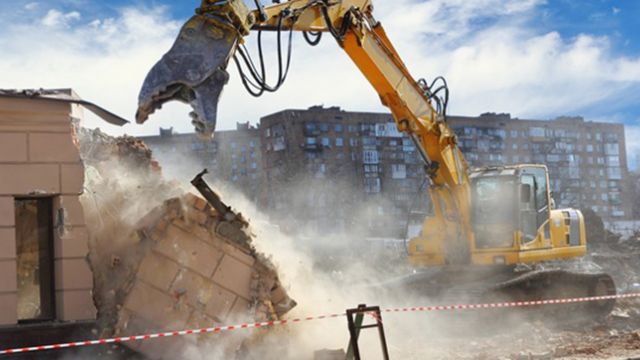10 trends defining the construction industry
Change is becoming a more welcome concept for builders
When experts discuss rapidly evolving industries, construction rarely makes its way into the conversation. In some ways, this exclusion is warranted, as veteran construction managers and executives have often been resistant to major advancements and new methods in their industry. Kevin Max, managing director of major projects advisory at KPMG’s New York office, called construction "an industry that evolves and moves rather slowly" during an interview with Construction Dive in May.
Change, however, is becoming a more welcome concept for builders, as many are embracing innovations and changing consumer tastes. At the same time, trends in the markets have a major impact on construction professionals, who must constantly keep up with the strength of the industry as it struggles to get back on its feet.
To help busy professionals stay up-to-date with the latest trends in the commercial and residential sectors, we’ve compiled a list of 10 major trends driving construction.
1. The shortage of qualified labor continues to plague the industry.
Everyone knew this was coming. During the recession and subsequent years of struggle for the building industry, qualified labor across all sectors fled in search of work elsewhere. Now that the industry is recovering, those workers just aren't coming back. The area hit the hardest has been skilled craft labor. Builders — in residential, commercial and industrial sectors — can't find the qualified workers they need for new projects. The Bureau of Labor Statistics recently found that contractors had 143,000 unfilled jobs on their books in June.The Associated General Contractors of America also reported this month that only 28 states added construction jobs between June and July. The association blames this "uneven growth" on tight budgets for federal and state projects — impacted largely by Congress' inability to pass long-term highway construction funding — as well as the exodus of older workers, the unreliability of construction jobs in an uncertain economy, and the lack of trade schools encouraging new construction employees to enter the field.
Although the construction industry has seen a strong rebound this year, its growth has been crippled by this lack of qualified labor. Unless more workers start to come out of the woodwork and enter the field, the pace of growth will continue to be disappointing.
2. The use of BIM and technology/apps on job sites is increasing.
Construction has been somewhat behind the times when it comes to adopting new technologies and innovations. In April, we reported on a Texas A&M study that found the construction industry lags behind many others when it comes to using mobile apps, cloud-based systems and other technology. However, some contractors have begun to realize the potential benefits of new tech options.Building Information Modeling has quickly become the most significant and widely adopted new technology method employed in the industry. The process of creating digital models to provide information for planning construction has proven beneficial for both safety reasons — as managers can use BIM to help assess risks on job sites and to plan ways to do more of the work off-site — and for economic reasons — as it can help contractors save thousands of dollars of unnecessary spending on scaffolding and staging.
Apps for phones and tablets have also emerged as game changers for the job site. A wide variety of apps are available that can help contractors view purchase orders, floor plans and site plans; schedule appointments; submit change orders; look up building codes and manufacturers’ instructions; track weather; and more. OSHA even offers a smart phone app that outdoor workers and supervisors can use to gauge the heat index of an outdoor work site — and the risk the crews face during any point of the day.
Construction professionals need to keep up with the latest technologies available, as they can save time, money and lives.
3. Homebuilding mergers and acquisitions will likely be on the rise after the major Standard Pacific/Ryland Group deal.
When Standard Pacific and the Ryland Group first announced their merger in May, analysts instantly offered predictions of an impending surge of similar mergers in the homebuilding industry, which has been in the midst of what Builder magazine called "an acquisition wave."Between 2012 and 2014, more than 20 mergers and acquisitions occurred between builders in an effort to create shareholder value, acquire land and improve operating efficiency. The Standard Pacific/Ryland merger, however, rocked the narrative, as the consolidation of the two publicly traded builders will create the fourth-largest homebuilder in the U.S. Earlier this month, the two companies announced their combined name would be the CalAtlantic Group.
Standard Pacific Chief Executive Scott Stowell told The Wall Street Journal he expected the major merger to lead to others. "We're out in front of what we think will be a wave of consolidation in our industry," he said.
His prediction has so far proven correct, as Taylor Morrison, the seventh-largest U.S. homebuilder by volume of sales, revealed its plans to start building in Chicago and two North Carolina markets after acquiring three divisions of 64th-ranked Orleans Homebuilders.
Which builders will be next to catch the merger wave? We expect more acquisition news to pop up throughout the year.
4. Tight home inventory (especially for starter homes) and rising home prices are creating a seller's market and hindering low-income and first-time buyers from entering the market.
The housing market is slowly crawling back from the depths of the recession. Economists keep a close eye on the residential industry’s stability, as it is a major indicator of the overall economy. But housing growth has been unable to kick into high-gear due to the lingering problem of a lack of affordable, available inventory on the market.Zillow reported fewer homes were available for sale in June than a year ago. The inability to find a home in an affordable price range makes the homebuying process even more difficult. And with a smaller supply of entry-level homes, more low-income buyers will be forced to remain renters.
At the end of August, Black Knight Financial Services found that home prices in 13 of the 40 metros surveyed hit new peaks.
As a result of this ultra-limited supply of homes, bidding wars have heated up. Sellers can price their properties higher because there aren't enough options for buyers to choose from.
Although home prices haven't risen as rapidly as rents, they have still steadily increased — making home purchases even further out of reach. In August, NAR chief economist Lawrence Yun said the rising prices of existing homes are exacerbating the nation's "inequality problem."
For the housing market to truly take off, housing inventory will need to expand greatly and give potential homebuyers a reason to make the leap into ownership.
5. Tiny houses are becoming more than just a fad and have builders taking notice.
Tiny houses have captured the attention not just of the building industry, but of the world. These microhomes have created a trend of small-living and off-the-grid lifestyles. The dwellings also are quick to build and cost an average of $23,000, according to The Tiny Life.While some expected tiny homes to be a passing fad, they have proven themselves to be a popular alternative to the rising prices of megahouses. The first official Tiny House Jamboree in Colorado Springs, CO, drew 40,000 people, and Brad Pitt's post-Hurricane Katrina recovery organization — Make It Right — marked the devastating storm’s 10th anniversary by constructing a model of a high-tech, energy-efficient microhouse.
So far, big builders have seemingly shied away from the growing popularity of these tiny homes, paving the way for small, craft builders to capitalize on the burgeoning market.
6. There has been heightened attention on job site safety and stricter punishments for managers and executives who put workers in danger.
Safety has always been an issue for the construction industry. According to the Bureau of Labor Statistics, construction laborers have the 10th most dangerous job in America. Recently, there has been more focus on job site safety and stricter penalties for those who contribute to an unsafe work environment.Just this month, a jury ordered New York Crane and Equipment Corp. owner James Lomma and his companies to pay $47.8 million to the families of two New York construction workers who died when a crane collapsed on their job site in 2008; and Joseph Kehrer and Kehrer Brothers Construction were slapped with $1.79 million in fines from OSHA for "willfully exposing" eight workers to asbestos.
Also during August, the owner and the project manager of a California construction company were sentenced to two years in prison for what Cal/OSHA called the "preventable death" of a day laborer who was buried alive in 2012. This case was particularly unusual, as contractors rarely get jail time for a job site accident. Dave Cogdill, executive director of the California Building Industry Association, said he had never heard of a jail sentence for a fatal construction accident in California.
These increasingly stronger punishments and higher penalties are meant to send a message to construction managers and contractors who allegedly cut corners when it comes to worker safety.
7. 3-D printing and off-site construction are emerging as possibly more efficient ways to build.
Will 3-D printing alter the construction industry forever? The jury is still out on that one. If it does have a significant impact, it will likely occur many years down the road. For now, however, builders are experimenting with the new technology, which can drastically reduce building time and costs. A technology startup in Chattanooga, TN, for example, is reportedly using the world's largest free-form 3-D printer to build walls for new homes.Builders are also eyeing 3-D printing options for in-space construction, as well as researching how to 3-D print a car and home — which can also share energy — from the same material.
Similarly, many are also improving efficiency through off-site construction methods. A Kansas City startup is building the city's first net-zero home using alternative construction processes to reduce costs and build time. To do so, the company plans to ship construction kits with pre-cut structural insulated panels, windows, fixtures and most other building materials, to the local builder who will construct the house.
8. The green building market is growing, and builders are often encouraged to adopt green practices.
Green building is far from a new concept, but environmentally friendly construction has been picking up steam and likely won't let up anytime soon.Carnegie Hall, for example, qualified this month for LEED Silver certification after a massive renovation to make 165,000 square feet of the concert hall’s non-performance space more energy-efficient.
President Obama's Clean Power Plan could also have significant implications for the green building movement in the commercial and industrial space, as his proposed standards include tax credits for electricity generated in 2020 and 2021 from renewable energy plants that begin construction early. The new standards could spur a wave of solar and wind farms across the U.S. Already, Colorado broke ground this month on the state's largest solar farm.
However, the green building movement has come with its fair share of controversy. The new 2015 International Energy Conservation Code has sparked debate among builders and environmentalists, who are debating which codes could potentially harm the building industry, despite possible benefits for the environment. One of the largest clashes occurred this month in St. Louis, MO, where the committee charged with recommending which new building codes the county should adopt recommended the county remove some of the measures meant to reduce energy usage in new homes due to higher costs.
The green building trend is here to stay, but it will likely continue to face opposition along the way.
9. Regulators and law enforcement have been cracking down on corruption in construction.
The construction industry is no stranger to corruption problems. Recently, there has been a surge of officials cracking down on corrupt developers and construction executives who used their businesses for their own gain.August saw a heat wave of corruption charges. At the start of the month, seven Florida construction executives were charged with pocketing $36 million in U.S. tax credits intended for government-subsidized, affordable housing projects in the Miami area. Later in August, a Las Vegas construction "kingpin" was ordered to serve 15.5 years in a federal prison and pay $13.4 million for his role in an elaborate scheme to take over the city's homeowners' associations and divert their construction contracts to his company.
To combat corruption in the construction industry, the Manhattan DA launched a task force earlier this month to identify and prosecute corruption in New York City's construction industry. With efforts like the Manhattan task force, the industry as a whole could start to see an influx of corruption charges and punishments designed to deter similar practices.
10. Builders are hoping millennials will finally start buying homes instead of staying renters.
Millennials seem to be all anyone can talk about when discussing the housing market. Will they finally leave the renting lifestyle and make the plunge into homeownership? Will student debt cause them to delay ownership even longer? The residential industry overflows with constant reports of buying activity for the coveted 18-34 age segment.Just this month, reports revealed: Millennials are more likely to put off buying their first homes than they are to postpone marriage or purchase cars; first-time homebuyers are renting for an average of six years before they buy, more than twice as long as in the 1970s; and sales of existing homes to first-time buyers fell in July to their lowest share since January, even as overall sales increased for the third consecutive month.
These reports paint a bleak picture of the current millennial-homebuying climate. To snag the young buyers, builders need to offer more entry-level home options at affordable prices.
About the Author
Emily Peiffer is the associate editor of Industry Dive’s Construction Dive publication. Hailing from Lancaster, PA, she received her BA from Susquehanna University. Before joining Industry Dive, Emily worked for Lancaster Newspapers and Science & Diplomacy, under the American Association for the Advancement of Science.
This article was originally published in Construction Dive. This content has been republished with the permission of the publisher.



















